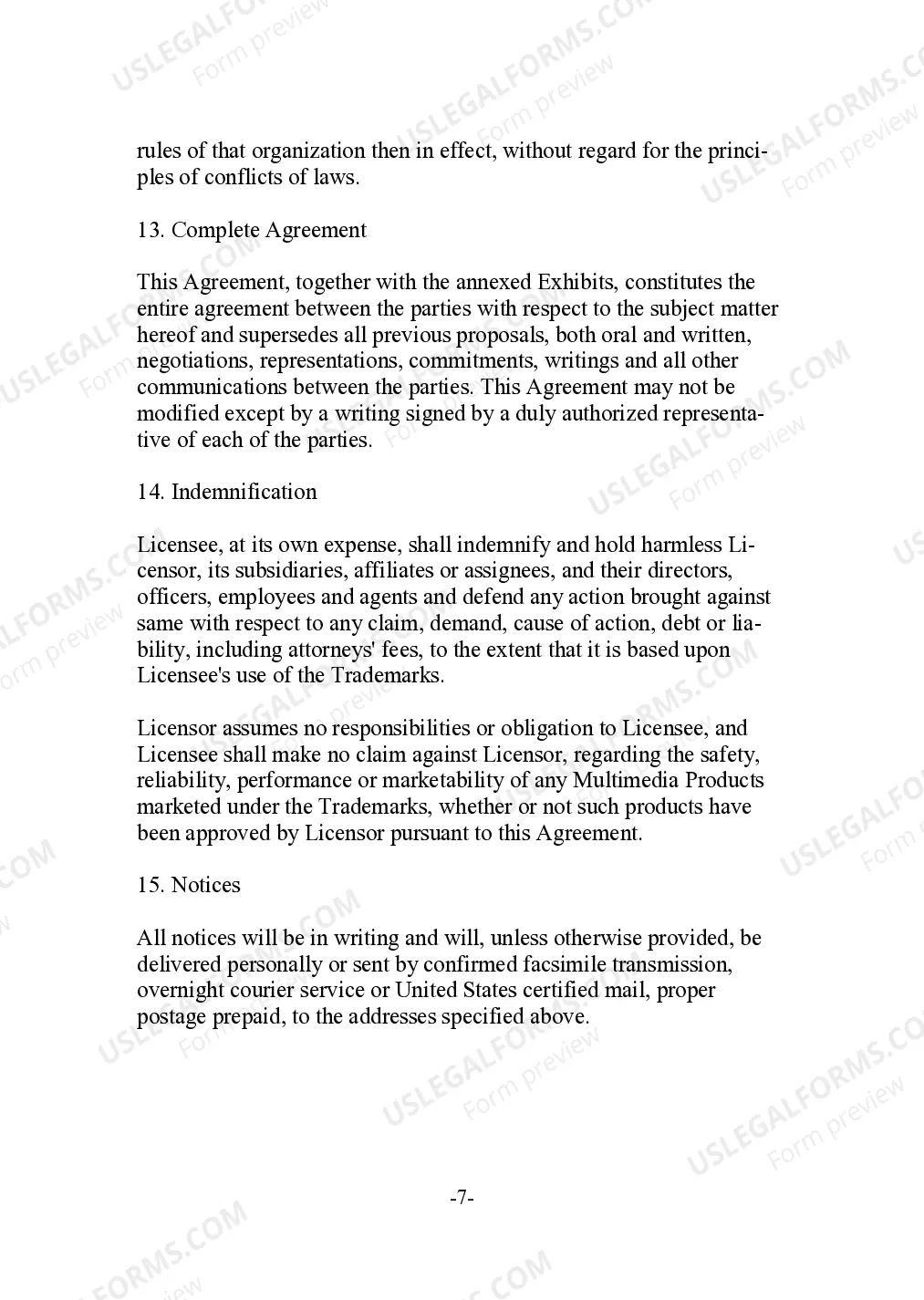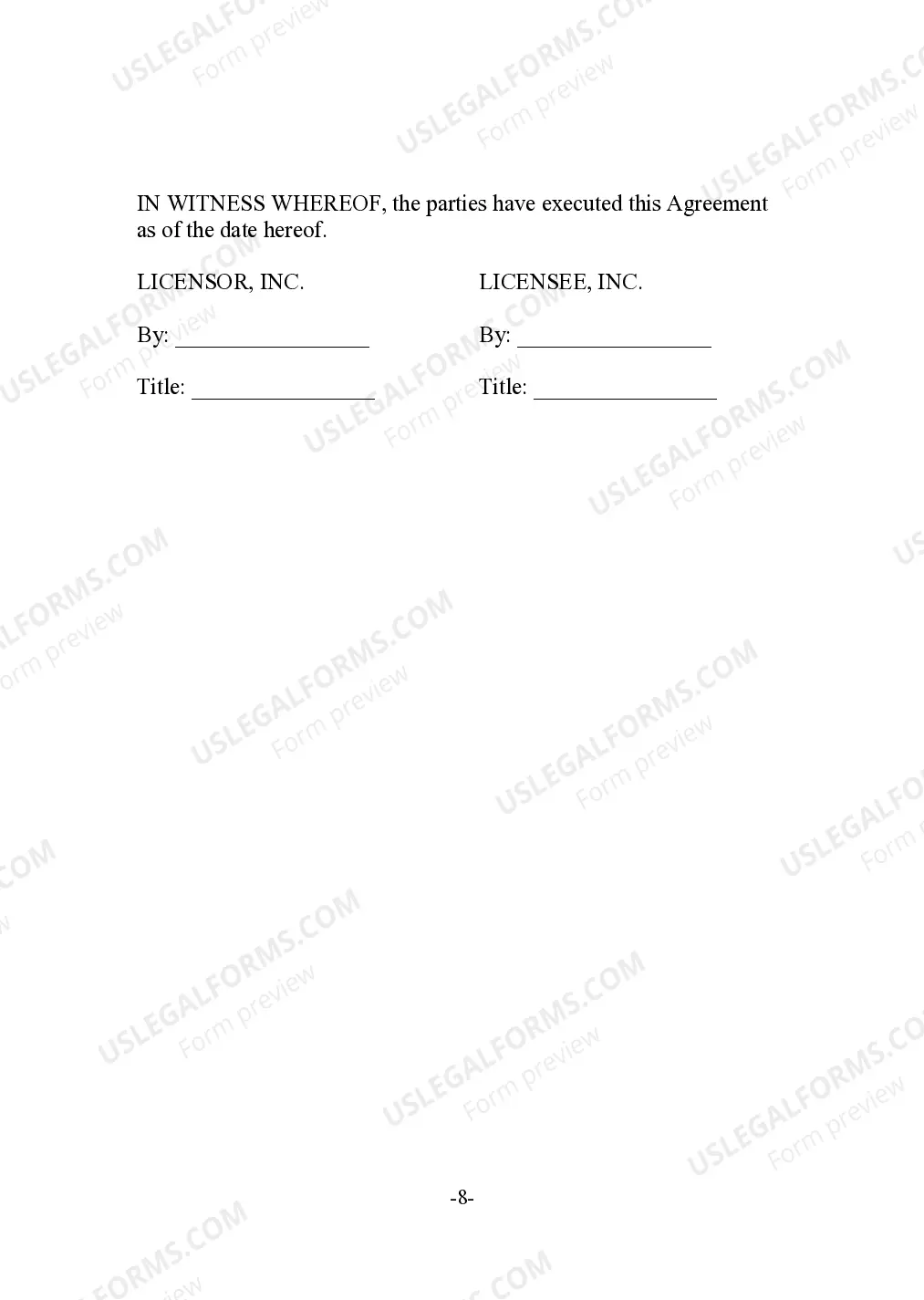A New York Trademark License Agreement for a Multimedia Business is a legal contract that establishes the terms and conditions for using a trademark within the multimedia industry. This agreement allows a multimedia business to grant permission to another party to use its trademark in connection with various multimedia services, products, or activities. It is crucial to have a well-drafted agreement to protect the rights and interests of both parties involved. Key elements typically included in a New York Trademark License Agreement for a Multimedia Business may include: 1. Parties: Clearly identify the parties involved, including the trademark owner (licensor) and the party receiving the license (licensee). 2. Effective Date: Specify the date when the agreement becomes effective. 3. Grant of License: Define the scope and type of license being granted. This may include the specific rights to use the trademark, such as reproduction, distribution, display, performance, or adaptation. Different types of licenses may be issued, such as exclusive licenses (granting sole usage rights) or non-exclusive licenses (allowing multiple parties to utilize the trademark). 4. Duration: Determine the time period for which the license is granted. It can be for a fixed term or indefinite, subject to any conditions for termination. 5. Territory: Specify the geographical region where the licensed trademark can be used, which can range from local to international territories. 6. Quality Control: Establish guidelines regarding the quality standards that the licensee must adhere to when using the trademark. This ensures that the reputation and integrity associated with the trademark are maintained. 7. Royalties or Fees: Outline the payment terms, including any upfront fees, royalties, or recurring payments that the licensee must provide to the licensor. 8. Intellectual Property Rights: Clearly state that the licensor retains all ownership and intellectual property rights related to the trademark, and that the agreement does not grant any ownership rights to the licensee. 9. Indemnification: Specify that the licensee assumes responsibility for any damages, liabilities, or legal claims arising from their use of the licensed trademark. 10. Termination: Define the conditions under which either party may terminate the agreement, such as breach of contract, non-payment of fees, or violation of the agreed terms. 11. Dispute Resolution: Provide a mechanism for resolving any disputes that may arise during the term of the agreement, such as through mediation, arbitration, or litigation in a New York court. Different types of New York Trademark License Agreements for a Multimedia Business could include: 1. Exclusive Trademark License Agreement: Grants sole and exclusive usage rights of the trademark to the licensee within the specified territory and industry sector. 2. Non-Exclusive Trademark License Agreement: Allows multiple parties to use the licensed trademark, as long as they comply with the terms and conditions set forth in the agreement. 3. International Trademark License Agreement: Specifically tailored for multimedia businesses operating globally, this agreement grants usage rights in multiple countries or regions. In conclusion, a New York Trademark License Agreement for a Multimedia Business is a crucial legal tool that enables a multimedia business to grant usage rights of its trademark to another party. By engaging in a well-drafted agreement, both parties can establish clear guidelines, rights, and obligations to protect their interests and maintain the integrity of the licensed trademark.
New York Trademark License Agreement for a Multimedia Business
Description
How to fill out New York Trademark License Agreement For A Multimedia Business?
US Legal Forms - among the largest libraries of lawful forms in the States - delivers a wide array of lawful file themes you can acquire or print out. While using web site, you can get thousands of forms for organization and individual reasons, categorized by types, suggests, or keywords.You will discover the newest models of forms such as the New York Trademark License Agreement for a Multimedia Business in seconds.
If you already have a registration, log in and acquire New York Trademark License Agreement for a Multimedia Business from your US Legal Forms library. The Obtain key will appear on each and every type you look at. You have access to all earlier acquired forms in the My Forms tab of your respective bank account.
If you would like use US Legal Forms for the first time, listed below are simple directions to get you began:
- Be sure you have picked out the proper type for your town/state. Go through the Preview key to review the form`s information. Browse the type outline to ensure that you have chosen the right type.
- In case the type doesn`t match your demands, use the Research industry at the top of the screen to find the one which does.
- When you are happy with the form, verify your decision by visiting the Purchase now key. Then, pick the costs plan you prefer and offer your credentials to register to have an bank account.
- Approach the deal. Use your bank card or PayPal bank account to finish the deal.
- Choose the formatting and acquire the form in your system.
- Make modifications. Load, modify and print out and indication the acquired New York Trademark License Agreement for a Multimedia Business.
Every template you put into your money does not have an expiration date which is yours permanently. So, in order to acquire or print out one more version, just check out the My Forms section and then click about the type you will need.
Gain access to the New York Trademark License Agreement for a Multimedia Business with US Legal Forms, one of the most considerable library of lawful file themes. Use thousands of professional and express-distinct themes that meet up with your small business or individual requirements and demands.








